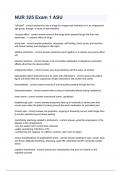NUR 325 Exam 1 ASU
"off-label" - correct answer-the use of drugs for unapproved indication or in an unapproved
age group, dosage, or route of administration
1st pass effect - correct answer-some of the drugs when passed though the liver may
deactivate —> reduces effect of drugs
acute pain - correct answer-protective, temporary, self limiting, direct cause, and resolves
with tissue healing, see changes in vital signs
additive interaction - correct answer-medicines work together in a positive way (same effect
x2)
adverse reactions - correct answer-a list of possible unpleasant or dangerous secondary
effects other than the desired effect
antagonistic effect - correct answer-one drug interferes with the action of another
appropriate patient interaction/care for client with Alzheimer's - correct answer-be patient,
figure out where they are cognitively, simple instructions, talk slower and calmly
bioavailability - correct answer-amount of oral drug after passing through the liver
biotransformation - correct answer-when a drug is chemically altered during metabolism
brand name - correct answer-commercial name, capitalized
breakthrough pain - correct answer-temporary flare-up of moderate to severe pain that
occurs even when the patient is taking around-the-clock medication for persistent pain
chronic pain - correct answer-not protective, ongoing or frequently occurs, lasts longer than
6 months, persists beyond tissue healing
client/family teachings related to alzheimer's - correct answer--what the progression of the
disease is like (progressive)
-how the patient can't control their outbursts
-safety (wandering, infections, UTI)
-sundowning (no napping, no caffeine, routines, dark room to sleep)
clinical manifestations of anaphylactic shock - correct answer-swelling of eyes, mouth, face,
and throat, difficultly breathing, wheezing, rapid HR, extremely low BP, eventually cardiac
arrest
cognitive impairment - correct answer-any characteristic that acts as a barrier to the
cognition process
, -Ex) delirium, neurocognitive disorders, focal cognitive disorders, intellectual disabilities,
learning disabilities, cognitive impairment not dementia
Contraindications - correct answer-drugs the provider should NOT prescribe because they
have potential to cause serious or life-threatening adverse effects
cumulative effect - correct answer-When the body cannot completely metabolize and excrete
one drug dose before next dose is given
Define the concept of stress - correct answer-Stress and coping is a continual process that
starts with an event that is experienced by the individual, perceived through intact
information processing channels, appraised for scope and meaning, assessed as neutral,
manageable, or threatening within current capacity of coping skills, resources and abilities,
ending ideally in a positive outcome of homeostasis and feeling of well being.
describe the concept of pain - correct answer-pain is complex, multidimensional experience,
with physiologic, affective, cognition, behavioral, and sociocultural dimensions that occurs in
many patients and in all settinsg
drug tolerance - correct answer-body decreased response to a drug over a period of time or
repeated use
drug toxicity - correct answer-excessive doses result in negative physiologic effects (can be
irreversible) may lead to OVERDOSE
duration - correct answer-time the drug lasts without additional doses
effects of untreated pain - correct answer-fear, anger, depression, anxiety, difficulty
maintaining relationships
generic name - correct answer-not capitalized, less expensive
half life - correct answer-time it takes for a drug that enters the body to decrease in half
Metabolism (biotransformation) - correct answer-The biochemical alteration of a drug into an
inactive metabolite, a more soluble compound, a more potent active metabolite, or a less
active metabolite
most severe adverse reaction - correct answer-anaphylactic shock
neuropathic pain - correct answer-abnormal processing of pain message; burning, shooting
in nature
nociceptive pain - correct answer-damage to somatic or visceral tissue; most common type
of pain; aching, throbbing, cramping
Non-pharmacological interventions for stress management - correct answer--exercise
-therapeutic lifestyle change




